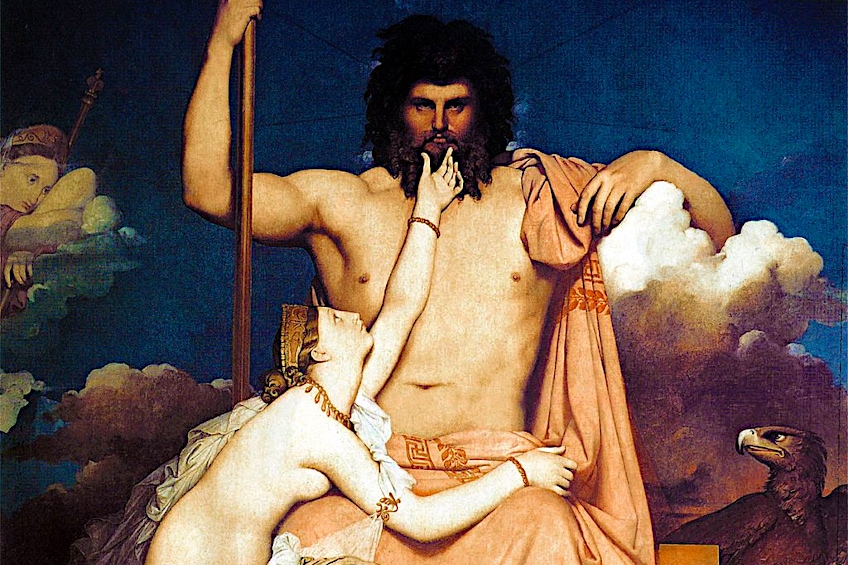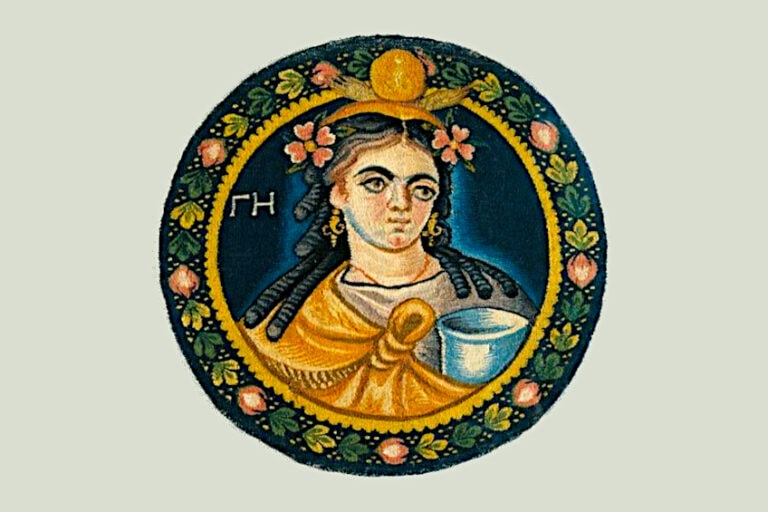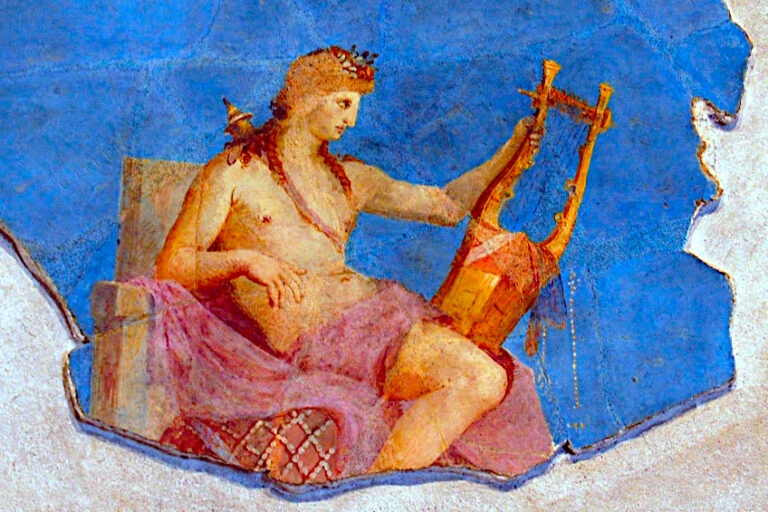Greek God Zeus – Ruler of the Olympian Pantheon
What is Zeus the god of and where can Zeus usually be found? Zeus is the renowned god of thunder in the Greek pantheon of gods and can typically be found on Mount Olympus. The Greek god Zeus is revered as the king of both men and other gods, and Zeus’ symbols include the thunderbolt and the scepter. Below, we will provide all the crucial facts about Zeus, such as who Zeus’ father and mother was, what his role was, and the myths associated with him.
Contents
The Story of the Mighty Greek God Zeus
| Name | Zeus |
| Gender | Male |
| Symbols | Thunderbolt, scepter, bull, eagle, and oak leaf crown |
| Personality | Fair, merciful, wise, and easily angered |
| Domains | Thunder, sky, lightning, air, weather, kings, justice, fate, and people |
| Parents | Cronus and Rhea |
| Spouse | Hera |
What is Zeus the god of? Zeus was in charge of the weather and provided omens and signs, and was the god of thunder. From his position atop Mt. Olympus, he enforced universal justice, ensuring order among both the deities and humans.
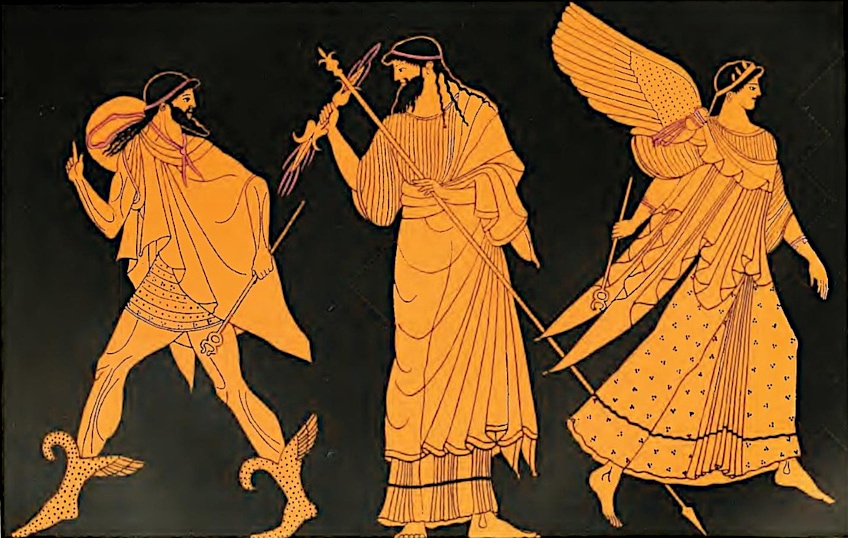 Drawing of Zeus dispatching his messengers Hermes and Iris (1875) copied from a red-figure vase; FRANÇOIS LENORMANT, Public domain, via Wikimedia Commons
Drawing of Zeus dispatching his messengers Hermes and Iris (1875) copied from a red-figure vase; FRANÇOIS LENORMANT, Public domain, via Wikimedia Commons
The name Zeus is believed to have come from the Ancient Greek word meaning “bright”.
The term is closely related to dies, which is “day” in Latin and has a long history. As a result, many mythologists consider Zeus to be among the oldest Greek gods.
Family and Background
Cronus was Zeus’ father, while Rhea was his mother. Cronus had taken over the sovereignty of the sky from Ouranos, his father, and he was endlessly anxious about his own offspring doing the same to him. To avoid being overthrown, he ate all of his offspring: Demeter, Hestia, Hades, Hera, and Poseidon.
His mother, Rhea, though, was able to save her youngest son Zeus by covering a stone in maternity blankets and handing it to Cronus to ingest.
Zeus was then taken away to Mount Dikte on Crete, where he was reared by the ancient goddess Gaia, or the Nymphs in some accounts.
Infancy
Based on the writings of Apollodorus, Rhea took Zeus to Ida and Adrasteia, the nymphs and daughters of Melisseus. They fed him Amalthea’s milk (a she-goat) while the Kouretes guarded the cave and banged their spears against their shields so Cronus was unable to detect the infant’s cries. In another version of this story by Hyginus, instead of devouring them, Cronus tossed Hades into the realm of the underworld, and Poseidon into the ocean. Hera then persuaded Rhea to give her Zeus and Rhea exchanged the infant with a stone and gave it to Cronus to swallow.
 Relief depicting the infant Zeus being fed the milk of the goat Amaltheia (first half of the 2nd Century); Rabax63, CC BY-SA 4.0, via Wikimedia Commons
Relief depicting the infant Zeus being fed the milk of the goat Amaltheia (first half of the 2nd Century); Rabax63, CC BY-SA 4.0, via Wikimedia Commons
In this version, Hera then took Zeus to Amalthea, who hung his cradle from a tree, so that he was not technically in either the earth, the sea, or the heavens, which meant that when Zeus’ father later went looking for him, he was nowhere to be found.
Zeus’ Ascension to Power
Cronus was compelled to regurgitate the five offspring and the stone once Zeus attained manhood, apparently in reverse order of ingestion, first throwing up the stone, then every one of the five children he had swallowed. Zeus then placed the stone in Delphi to serve as “a sign to mortal men”. Known as the “omphalos” this sacred stone was thought to mark the center or navel of the world.
 Depiction of Orestes (center) grasping the Omphalos while seeking sanctuary at Delphi on an Apulian red figure volute-krater (c. 350 BCE); ArchaiOptix, CC BY-SA 4.0, via Wikimedia Commons
Depiction of Orestes (center) grasping the Omphalos while seeking sanctuary at Delphi on an Apulian red figure volute-krater (c. 350 BCE); ArchaiOptix, CC BY-SA 4.0, via Wikimedia Commons
Zeus then released the Cyclops, who, in return for his release, gave him his thunderbolt, which had originally been concealed by Gaia. The fight for the dominion of the cosmos between the Olympians and the Titans then started. The war lasted 10 years with no obvious winner until Zeus, on Gaia’s proposal, freed the Hundred-Handers, who had been imprisoned under the surface of the earth. Zeus then began his last attack on the Titans, hurling lightning bolts at them while the freed Hundred-Handers struck them with rock barrages, and the Titans were eventually defeated.
Following the Titans’ defeat, Zeus divided the world with his brothers, Hades and Poseidon. Zeus was given the skies, Poseidon the waters, and Hades the realm of the underworld, whereas Olympus and the Earth remained a common ground for the gods.
Role and Significance
As the king of all the Olympian gods, Zeus is regarded as very significant. He played the role of both punisher and peacemaker. Individuals who did wrong or conducted detestable acts were harshly punished, often for the rest of their lives. After deeds of immorality against Apollo, Zeus, and Poseidon, the Titans were held captive in Tartarus and forced to construct the great fortifications of Troy, which proved so beneficial in the Trojan War. According to legend, Zeus willed the events leading up to the Trojan War which he saw as an opportunity to purge the earth of too many humans. He therefore chose one of the princes of Troy to be the judge in the renowned beauty contest between Hera, Aphrodite, and Athena, and when the young prince received Helen as his prize for selecting Aphrodite, it was considered as yet another, more human reason for the Trojan War.
As every man who had courted Helen before her marriage had to agree to come to her husband’s aid in future, her abduction meant that the entire Greek world would be drawn into the war to get her back.
Once the war was underway, Zeus allowed many Greek lives to be lost after the goddess Thetis asked him to prevent the Greeks from defeating the Trojans, until they had apologized to her son Achilles for allowing king Agamemnon to disrespect him. Achilles only re-entered the fray when his best friend Patroclus was killed by the Trojan prince Hector.
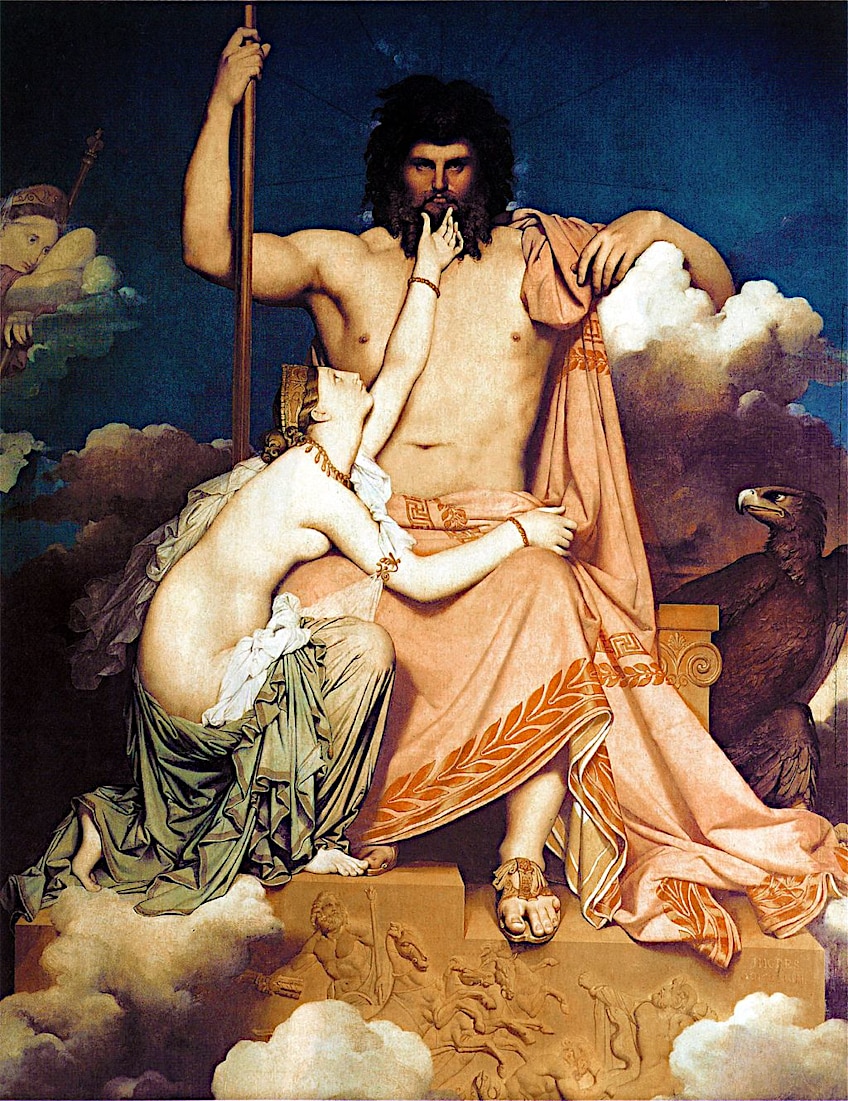 Zeus and Thetis by Jean Auguste Dominique Ingres (1811); Jean Auguste Dominique Ingres, Public domain, via Wikimedia Commons
Zeus and Thetis by Jean Auguste Dominique Ingres (1811); Jean Auguste Dominique Ingres, Public domain, via Wikimedia Commons
Other unfortunate recipients of Zeus’ retribution included the Titan Prometheus, who was sentenced to have an eagle devour his liver every day for stealing fire from the gods and giving it to humanity. Atlas was forced to keep up the skies for all eternity due to his involvement in the Titanomachy. Sisyphus received punishment for his deceit by being sentenced to perpetually rolling a massive stone uphill in the Underworld.
Because Asclepius’ medicine and capacity to revive the dead upset the balance that existed between mankind and gods, he was fatally wounded by one of Zeus’ thunderbolts.
Zeus sent Pandora into the world as punishment for Prometheus giving humans the fire he stole from the gods. Hephaestus created Pandora (whose name means all gifts) to be both exceptionally beautiful and deceitful. Prometheus’ brother Epimetheus joyfully received her and with her the large amphora or box she brought with her as a dowry.
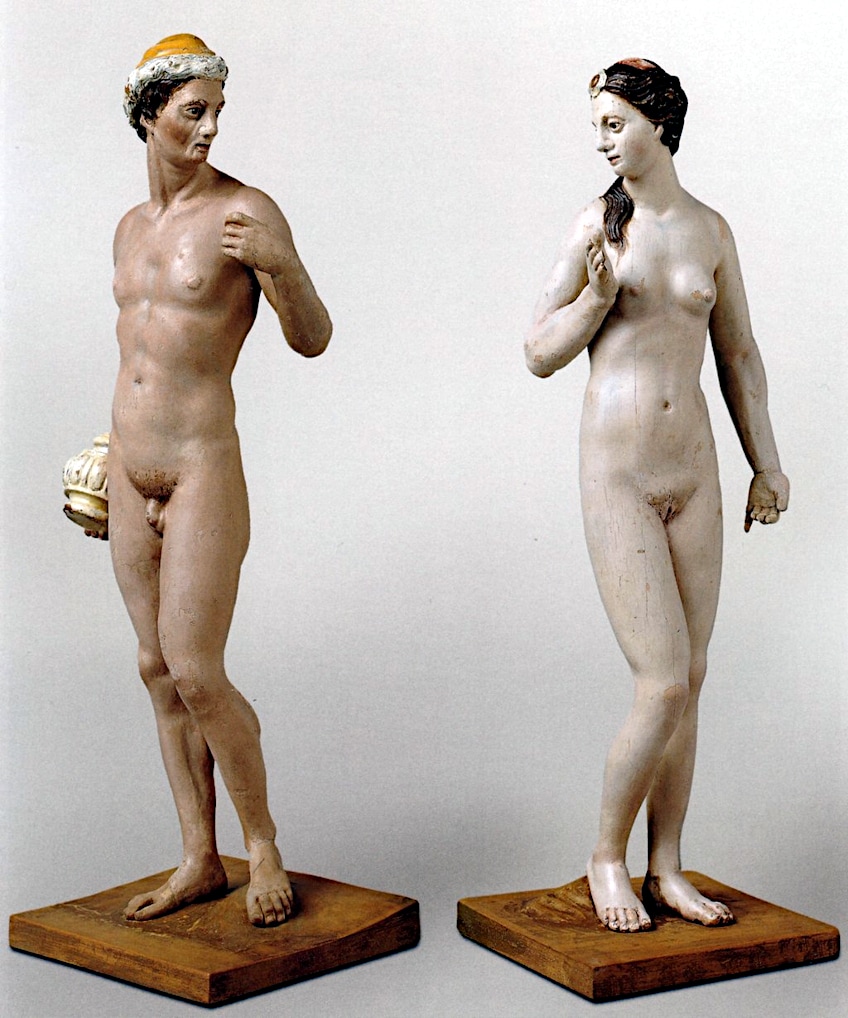 Epimetheus and Pandora attributed to El Greco (1600’s); Jvallmitja, CC BY-SA 4.0, via Wikimedia Commons
Epimetheus and Pandora attributed to El Greco (1600’s); Jvallmitja, CC BY-SA 4.0, via Wikimedia Commons
Unfortunately this “gift” held all the miseries that still plague humans like illness, anger, hunger, injustice, and death. These escaped when Pandora dismissed warnings not to look inside, and opened the container.
Phineus, who had been deceived by Hera into blinding his own sons, was blinded by Zeus and also sent the Harpies to taunt him. Ixion foolishly confessed his affection for Hera, so Zeus sent him to Hades, where he was permanently confined to a whirling wheel. Lycaon tested Zeus’ holiness by feeding him human flesh, and the deity cursed him by transforming him into a wolf. Salmoneus believed he was divine and claimed to be Zeus by tossing blazing torches for lightning bolts and racing his chariot to make a thunderous roar, but Zeus quickly put a stop to his tricks by immediately slaying him with an actual bolt of lightning.
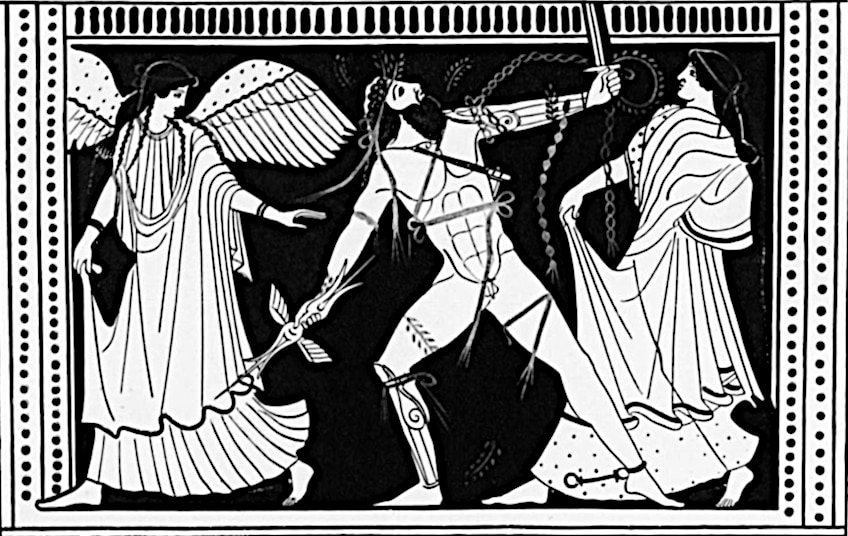 Drawing of Salmoneus (1899) copied from an Attic red-figure column crater (first half of the 5th Century BCE); AnonymousUnknown author, Public domain, via Wikimedia Commons
Drawing of Salmoneus (1899) copied from an Attic red-figure column crater (first half of the 5th Century BCE); AnonymousUnknown author, Public domain, via Wikimedia Commons
Despite his severe punishments, Zeus was also a mediator, memorably reuniting Hermes and Apollo after their dispute over the first lyre. In a similar manner, Zeus settled the dispute between Hercules and Apollo over the Delphi tripod. He also convinced Hades to release Persephone for a certain amount of every year, therefore ending the severe drought caused by her mother Demeter in resentment at being imprisoned in the Underworld.
Zeus was regarded as fair-minded in comparison to lowly mortals. He held the jars of Fate at his feet, one full of foul things and the other full of pleasant things, and he dispensed with them with fairness. Similarly, Zeus’ golden scales were used to precisely weigh the time of a human’s death.
The Personality and Attributes of the Greek God Zeus
Zeus was typically portrayed in mythology as mighty, inventive, and temperamental. He was a multifaceted god with both positive and negative characteristics. He was powerful and knowledgeable, but he was also fickle and easily angered. He was well-known for his ability to turn circumstances to his advantage, usually outwitting his adversaries with his knowledge and wit.
Zeus was also notorious for his fiery anger. He was often enraged and would lash out at anybody who disobeyed him or challenged his power.
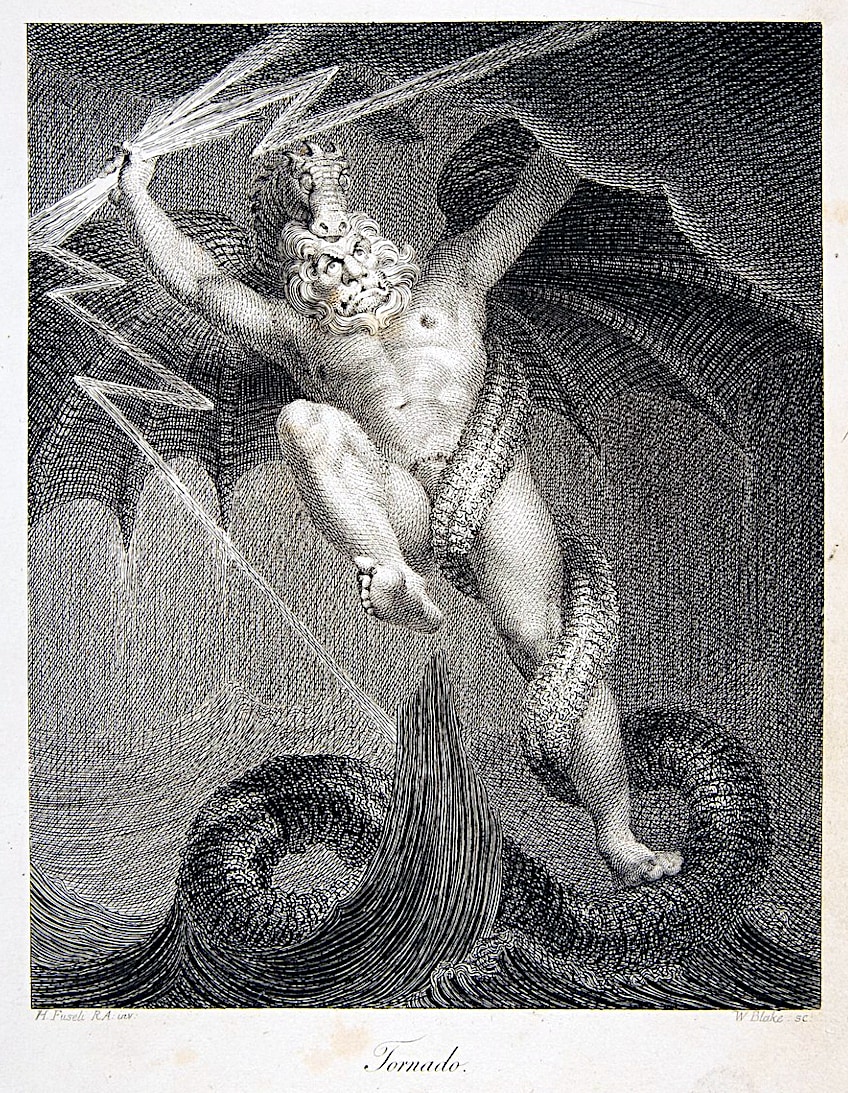 Tornado–Zeus Battling Typhon by William Blake (1795); William Blake, CC0, via Wikimedia Commons
Tornado–Zeus Battling Typhon by William Blake (1795); William Blake, CC0, via Wikimedia Commons
His adultery was infamous, usually having several partners at a time, which enraged his wife, Hera, who constantly sought vengeance against those that he had been with.
Zeus and the Sun
Zeus is commonly associated with Helios, the Hellenic sun deity, who is either openly referred to be Zeus’ eye or clearly indicated to be such. According to Hesiod, Zeus’ eye is basically the sun.
This belief may have originated in the early Proto-Indo-European belief system, in which the sun is sometimes regarded as the eye of Pater.
Euripides characterized Zeus as “sun-eyed” in his now-lost tale Mysians, while Helios is reputed to be “the luminous eye of Zeus, the life giver” elsewhere. The chorus of another of Euripides’ plays, Medea, describes Helios as “the light that was born from Zeus”.
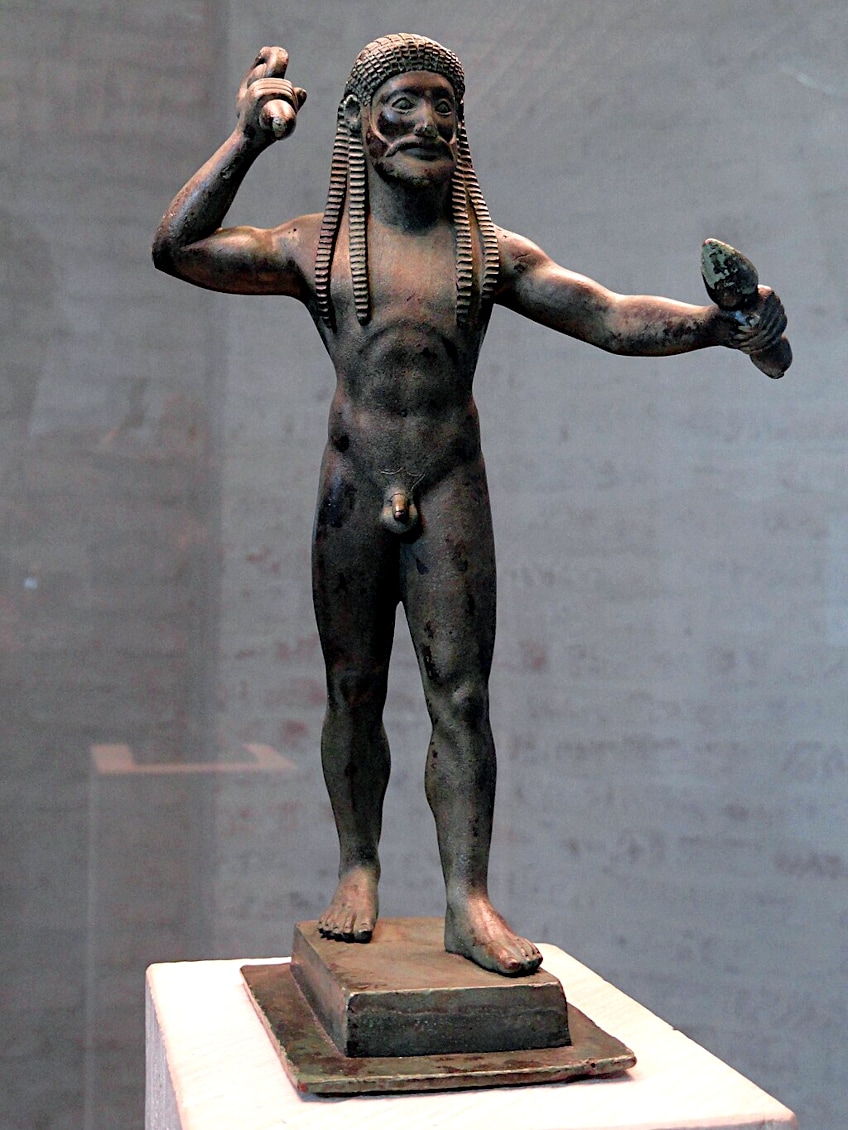 Archaic bronze statuette depicting Zeus hurling a thunderbolt; Glyptothek, CC0, via Wikimedia Commons
Archaic bronze statuette depicting Zeus hurling a thunderbolt; Glyptothek, CC0, via Wikimedia Commons
Zeus and Other Gods
Zeus was linked with Jupiter, the Roman god, and also closely associated with a variety of other divinities, including the Etruscan Tinia and the Egyptian Ammon, in the interconnected classical imagination. He and Dionysus assumed the status of the major Phrygian god Sabazios in the integrated divinity known as Sabazius in Rome. The Seleucid emperor Antiochus IV Epiphanes constructed an idol of Zeus Olympios in Jerusalem’s Judean Temple. The monument was known as Baal Shamen by Hellenic Jews.
Zeus is also associated with the Hindu god Indra. They are not only both the monarch of the gods in their pantheons but their weapons – thunderbolts – are also comparable.
The Underground Zeus
Despite the fact that etymology suggests Zeus was initially a sky deity, many Greek communities revered a local Zeus who dwelt below. Zeus Meilichio was revered by Sicilians and Athenians, while Zeus Katachthonios, Zeus Chthonios, and Zeus Plousios were recognized by other cities.
In visual art, these deities are often depicted as snakes or as humans, or both simultaneously in one image for impact.
They, like chthonic goddesses Demeter and Persephone, received offerings of black animal sacrifices slaughtered into subterranean pits. White animal bodies sacrificed on elevated altars were typically offered to Olympian gods. Cities were sometimes unsure if the daemon they worshiped was a hero or an underworld Zeus.
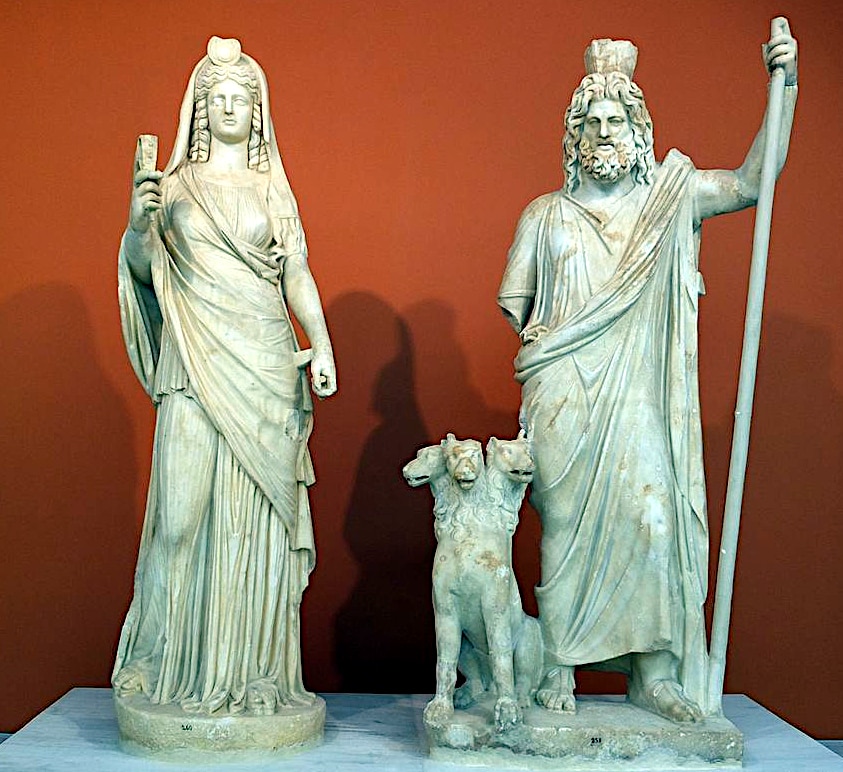 Statues of Isis-Persephone holding a sistrum and Zeus-Serapis with the three-headed hound of Hades (c. 180 -190 CE); Matthiasberlin, CC BY-SA 3.0, via Wikimedia Commons
Statues of Isis-Persephone holding a sistrum and Zeus-Serapis with the three-headed hound of Hades (c. 180 -190 CE); Matthiasberlin, CC BY-SA 3.0, via Wikimedia Commons
Zeus’ Symbols
The most prominent symbol connected with Zeus was the thunderbolt. He used them as a weapon to manipulate the weather to slaughter his foes in Greek mythology. The thunderbolt represented Zeus’ might, authority, and capacity to command nature’s powers. He was usually portrayed in ancient Greek art launching thunderbolts from the sky, demonstrating his dominion over the universe. Zeus’ grandeur and strength were represented by the eagle. It was considered to be a god’s messenger and was shown sitting on either Zeus’ arm or shoulder. The eagle was also a sign of triumph, related to the god’s responsibility as a warrior defender. Zeus is said to have turned himself into an eagle in order to spy on mankind or carry out his own plans.
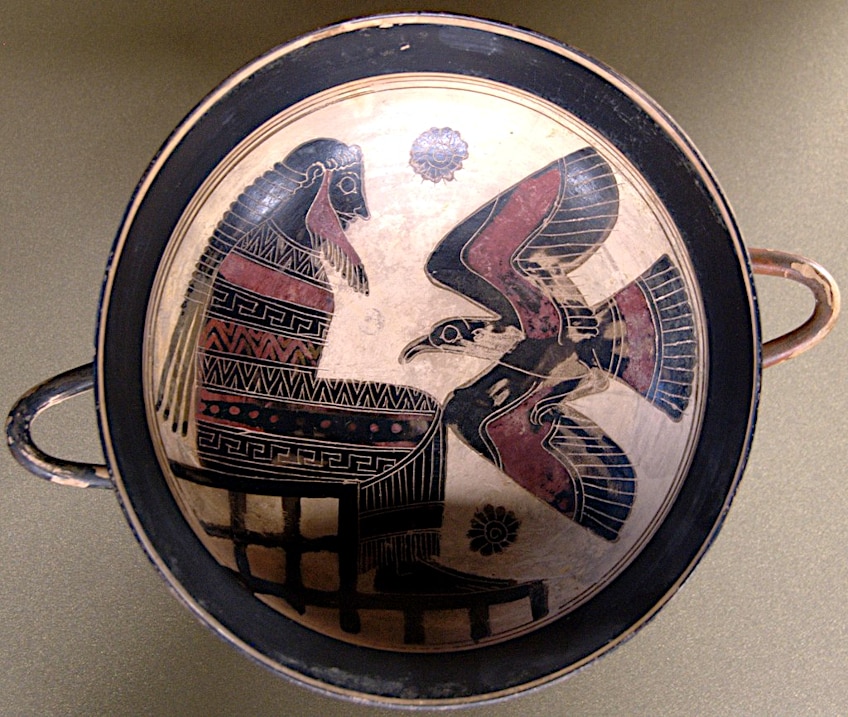 Depiction of Zeus with an Eagle on a black-figured Laconian cup (c. 560 BCE); Louvre Museum, Public domain, via Wikimedia Commons
Depiction of Zeus with an Eagle on a black-figured Laconian cup (c. 560 BCE); Louvre Museum, Public domain, via Wikimedia Commons
Zeus considered the oak tree to be holy and his favorite tree. It had an association with power, stamina, and endurance, and was used to represent Zeus’ immortality and power. Zeus was thought to have turned himself into an oak tree in various legends to evade discovery or as an indication of his heavenly presence.
Zeus’ authority and strength as the presiding king of all the gods were symbolized by the scepter. It often appeared as a long staff topped with ornate decoration, and it represented Zeus’ power over the universe. The scepter was thought to have magical abilities that enabled Zeus to manipulate the weather, heal the ill, or bestow benefits on those who followed him in certain legends.
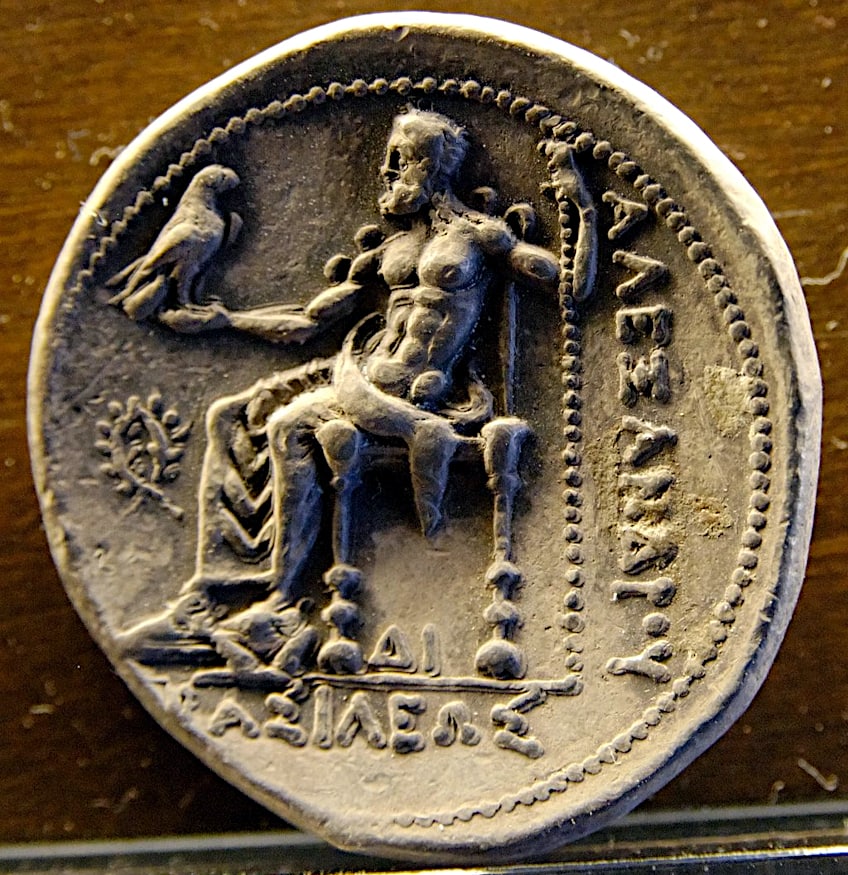 Coin from the reign of Alexander the Great depicting Zeus seated on a throne, holding an eagle in his right hand and a scepter in his left; Museum of Fine Arts of Lyon, CC BY 2.5, via Wikimedia Commons
Coin from the reign of Alexander the Great depicting Zeus seated on a throne, holding an eagle in his right hand and a scepter in his left; Museum of Fine Arts of Lyon, CC BY 2.5, via Wikimedia Commons
Zeus’ status as a virility god was connected with the bull. It was frequently used as an offering in his honor since it was thought to signify strength and sexual potency. In other myths, Zeus has been said to have turned himself into a bull in order to entice human women or to evade danger. The aegis was a shield or armor associated with Zeus that was described as being constructed of goat or snakeskin and frequently incorporated the severed head of the Gorgon. It was portrayed as part of the god’s armor or as a decorative element on other things.
The aegis was a sign of Zeus’ strength as well as protection, and it was thought to have the ability to fend off evil and keep the wearer safe.
Physical Traits of Zeus
Greek God Zeus was usually represented in Greek mythology as a tall, muscular figure with a majestic disposition and a thick beard. He was usually depicted donning a long tunic, as well as a crown of oak leaves on his head. He also appeared with a scepter in one hand while holding a thunderbolt in the other. Zeus is believed to have eyes that were piercing and an intimidating appearance, signifying his authority and strength as a god-king. His long hair and thick beard were seen as indications of power and virility.
Zeus appeared in ancient Greek art in a range of stances and circumstances, from sitting on his throne to standing with one foot lifted. He often appears with other gods and goddesses or is portrayed presiding over major events such as wars or rituals. Zeus is a key character of the Parthenon’s east pediment, but the most imposing image of the deity is a bronze statue from Artemesium (460 BCE), in which he courageously stands, feet wide apart, prepared to fire a thunderbolt.
Some academics suspect the figure is Poseidon, but J. Boardman, a renowned historian makes a compelling case that the stance is more akin to Zeus depictions in Greek art, along with the fact that if the figure held a trident, it would obscure the face, as the trident is much larger and longer than a lightning bolt, which was considered a bad aesthetic result for a Greek sculpture. Greek pottery is yet another rich source of Zeus’ traits, particularly pictures depicting his numerous metamorphoses, and Zeus appears on many coins, particularly those of Elis.
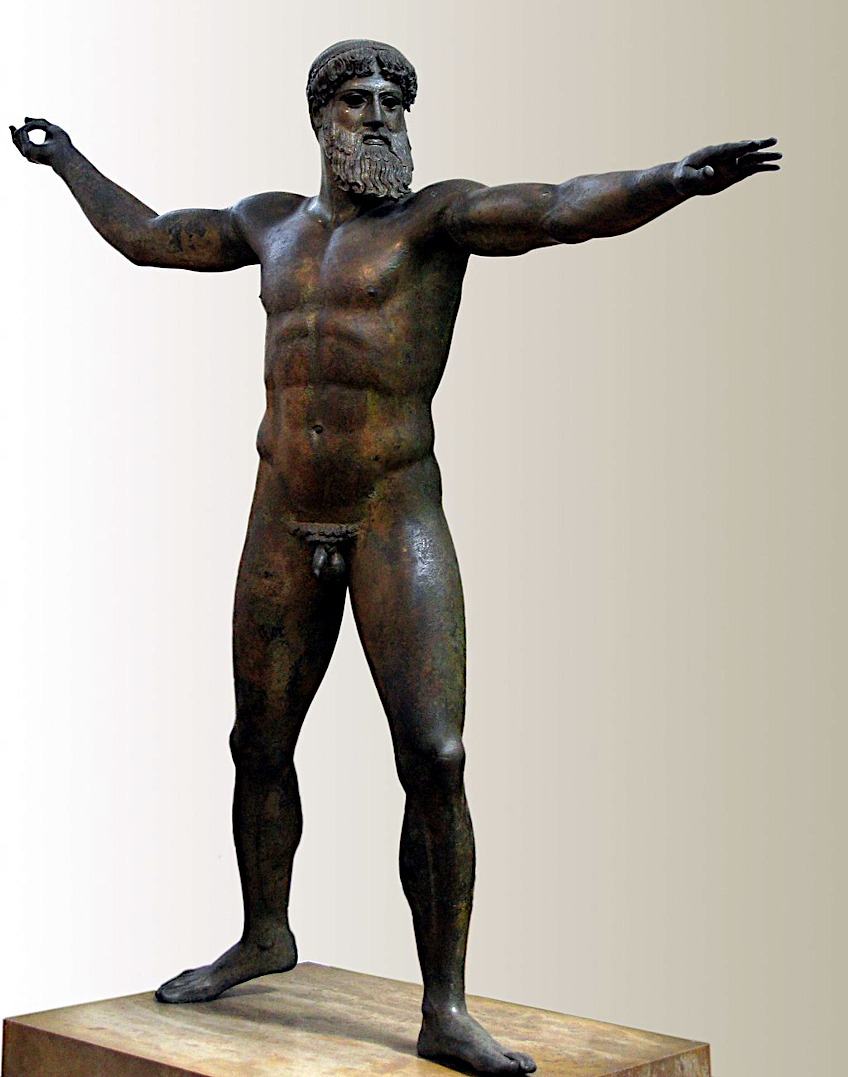 God of Cape Artemision (c. 460 BCE); Ismoon (talk) 13:38, 14 November 2021 (UTC), CC BY-SA 4.0, via Wikimedia Commons
God of Cape Artemision (c. 460 BCE); Ismoon (talk) 13:38, 14 November 2021 (UTC), CC BY-SA 4.0, via Wikimedia Commons
The Sacred Sites of Zeus
Where can Zeus usually be found? Zeus had an oracle due to being a significant figure in Greek mythology. It was the earliest in fact, in Dodona in northern Greece, where austere monks maintained an oracle that deciphered the wind’s sounds in the sacred oak trees’ branches and the babble of water from the sacred spring. Another important Zeus shrine was at Olympia, where the Olympic Games gathered throngs from all over the Greek world every four years commencing from 776 BCE to honor the father of the gods, and where 100 bulls were offered as offerings to Zeus at the end of each gathering.
At Olympia, the huge 5th century BCE temple of Zeus held the massive ivory and gold statue of the deity by Pheidias, regarded as one of the ancient world’s Seven Wonders.
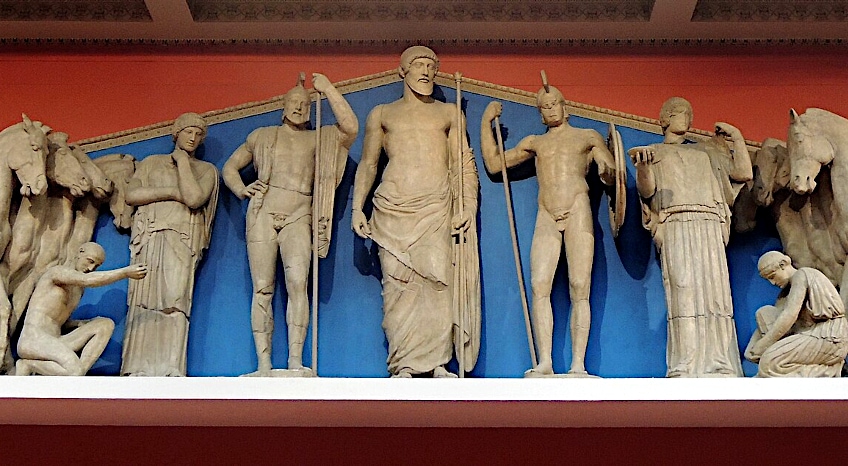 Reconstruction of the pediment of the Temple of Zeus in Olympia; shakko, CC BY-SA 4.0, via Wikimedia Commons
Reconstruction of the pediment of the Temple of Zeus in Olympia; shakko, CC BY-SA 4.0, via Wikimedia Commons
Other holy locations for the deity were Mt. Lycaios, Athens, Pergamon, Nemea, Stratos, and Libya. There were unusually few Zeus celebrations, one of which was the Diasia of Athens. In general, Zeus, as the leader of the Greek pantheon, was everywhere and hence had no special attachments to specific locations. Zeus, though, was worshiped in most homes, with an altar devoted to him in each courtyard, because as Zeus Herkeios, he safeguarded the home and property.
The Cults of Zeus
Zeus was worshiped in a variety of caverns in Crete, including Ida, Knossos, and Palaikastro. During the Hellenistic era, a tiny temple devoted to Zeus Velchanos was established on the remains of a long-ruined Minoan palace at Hagia Triada. An adolescent rests among the limbs of a tree, with a rooster on his knees, as seen on coins from Phaistos. Zeus Velchanos is shown as an eagle on other Cretan coins, together with a deity commemorating a mystic marriage.
Zeus Velchanios was still highly revered in Hellenistic Crete, as evidenced by inscriptions at Lyttos and Gortyn, which mention a Velchania celebration. According to the tales of Epimenides and Minos, these caverns were previously utilized for divination by priests and rulers.
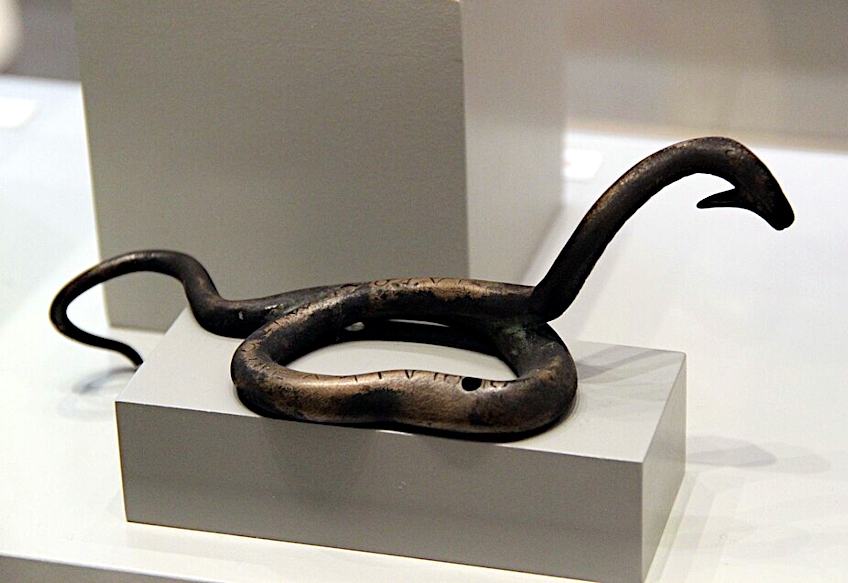 Bronze Votive in the shape of a Serpent with dedicatory inscription to Zeus Meilichios (1st half of 5th Century BCE); Gary Todd from Xinzheng, China, CC0, via Wikimedia Commons
Bronze Votive in the shape of a Serpent with dedicatory inscription to Zeus Meilichios (1st half of 5th Century BCE); Gary Todd from Xinzheng, China, CC0, via Wikimedia Commons
Plato’s Laws is set in an intriguing setting along a pilgrimage path to one such location, highlighting traditional Cretan wisdom. Zeus was shown in Cretan art as a long-haired youngster instead of a mature adult. The myth of Cretan Zeus’ death, which was localized in numerous mountain sites but only referred to in a relatively late source, Callimachus, combined with Antoninus Liberalis’ claims that a flame shone forth every year from the birth cave that the baby shared with a fabled swarm of bees, indicates that Velchanos was a yearly vegetative spirit.
According to the Hellenistic author Euhemerus, Zeus was once a powerful king of Crete, and his splendor gradually transformed him into a divinity after his death. The writings of Euhemerus weren’t preserved, but the idea was taken up by Christian patristic writers.
Zeus Lykaios
Zeus assumed the name Zeus Lykaios solely in relation to the archaic Lykaia festival on Mount Lykaion’s slopes, the highest peak in rural Arcadia; The Greek god Zeus had only formal ties with the rituals and legends of this primitive ceremony, which included the ancient danger of cannibalism as well as the likelihood of transformation into a werewolf for the ephebes who participated.
Every nine years, a certain clan would meet on the peak to perform a sacrifice to Zeus Lykaios, and just one piece of human entrails would be mixed in with the animals’.
Anyone that consumed the human flesh was believed to transform into a wolf and was only able to resume human form if he did not consume the flesh of a human again until the following nine-year cycle finished. There were games related to the Lykaia, which were relocated in the fourth century to Megalopolis, Arcadia’s earliest city; there, the principal temple was devoted to Zeus Lykaios.
Zeus in the Bible
Zeus is referenced twice in the New Testament, the first time in Acts 14:8-13: When the inhabitants of Lystra watched Paul heal a crippled man, they worshiped him and his companion Barnabas as gods, associating Barnabas with Zeus and Paul with Hermes and even presenting offerings to them with the rest of the people. Two ancient inscriptions uncovered near Lystra in 1909 attest to the city’s devotion to these two deities.
One inscription cites “Priests of Zeus”, while another references “Zeus the Sun-God”. The second instance is in Acts 28:11 when the title of the vessel in which Paul set sail from Malta had the emblem “Sons of Zeus”.
The Myths of the Greek God Zeus
As the king of the Olympians, there are many myths associated with the Greek god Zeus. We have already touched on a few myths associated with Zeus, such as the story of his birth, as well as his defeat of the mighty Titans. Let’s examine a few of his most important myths in more detail.
Zeus and Europa
Europa, according to Greek mythology, was regarded to be the pinnacle of feminine beauty on Earth. Zeus once observed her playing with the other girls on the shores of Phoenicia. He was so taken with her attractiveness that he instantly fell in love with her and had an intense desire to possess her. He immediately transformed into a white bull and approached her. The bull was stunning with its snow-white body and gem-like horns. Europa was intrigued by the remarkable animal and ventured to touch it since he appeared peaceful to her. Later, she was persuaded to get on his back.
As soon as she had climbed on, Zeus raced to the ocean and took her all the way to Crete. He resumed his usual form and married her beneath an evergreen tree. This was the kidnapping of Europa, who eventually gave birth to Zeus’ three sons, Rhadamanthys, Minos, and Sarpedon. When these sons eventually died, they became the Underworld’s three judges because they were celebrated for their impartiality. Minos created the town of Knossos and named an entire culture after himself, the Minoan civilization.
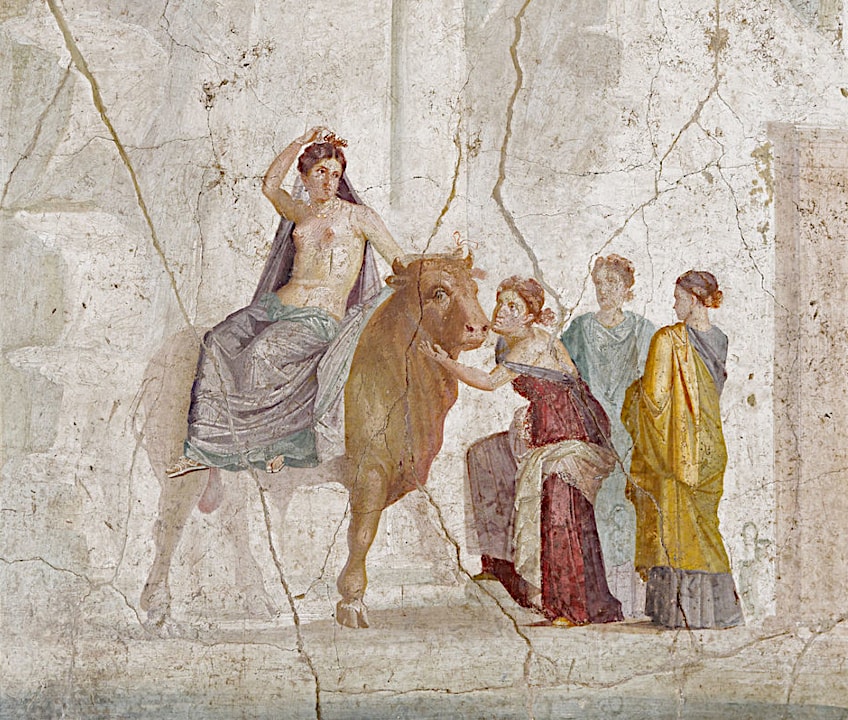 Fresco from Pompeii depicting Europa on the Bull (1st Century CE); Naples National Archaeological Museum, Public domain, via Wikimedia Commons
Fresco from Pompeii depicting Europa on the Bull (1st Century CE); Naples National Archaeological Museum, Public domain, via Wikimedia Commons
Zeus adored Europa and lavished her with three magnificent gifts. Talos, a bronze man who worked as her bodyguard, was the first. He was the bronze giant encountered by the Argonauts who then killed him during their attempt to land on Crete. The second was Laelaps, a dog that could hunt whatever she desired. The final gift was a javelin with the power to hit whomever the target was. Europa eventually married one of Crete’s monarchs, Asterius, who raised her boys and anointed her as the island’s first queen. When Europa died, Zeus is believed to have converted her into a star constellation, and he himself assumed the appearance of a white bull to join with the stars. The Taurus Constellation is thought to be Zeus’s form.
Today, one of Jupiter’s 16 moons is known as Europa, and this moon is unique in that it is thought to contain water.
Zeus and the Giants
Zeus’ reign was immediately challenged after gaining his position as the ruler of the cosmos. The Giants, who fought the Olympians in a conflict known as the Gigantomachy, were the first to threaten his authority. Based on the writings of Hesiod, the Giants are Gaia’s progeny, born from the blood droplets that spilled on the ground after Cronus castrated Uranus; yet, the Theogony makes no mention of a conflict between the Giants and the gods.
Apollodorus gives the most detailed description of the Gigantomachy. He claims that Gaia birthed the Giants to Uranus in retaliation for Zeus imprisoning her offspring, the Titans.
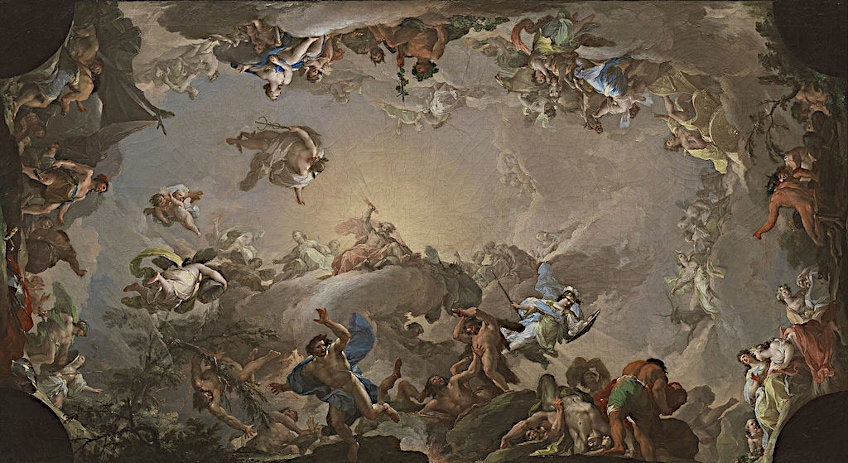 Olympus: The Fall of the Giants by Francisco Bayeu y Subías (1764); Francisco Bayeu y Subías, Public domain, via Wikimedia Commons
Olympus: The Fall of the Giants by Francisco Bayeu y Subías (1764); Francisco Bayeu y Subías, Public domain, via Wikimedia Commons
The gods received a prediction that the Giants could not be beaten by the Olympians alone, but had to be assisted by a mortal; upon hearing this, Gaia sought a specific plant that could stop the Giants from being slain. Zeus ordered Eos, Selene, and Helios to stop shining and collected all of the herb himself before summoning Heracles. During the conflict, one of the most mighty of the Giants, Porphyrion, attacked Hera and Heracles; yet, Zeus induces Porphyrion to fall in love with Hera, and just as he is about to try and rape her, Zeus strikes him down with one of his thunderbolts, before Heracles delivers the fatal strike using an arrow.
Zeus and Typhon
After Zeus kills the Titans, the monster Typhon, a huge serpentine creature that opposes Zeus for dominance of the cosmos, challenges his dominion. Typhon is the child of Tartarus and Gaia, with 100 snaky fire-breathing heads.
He might have come to rule over both humans and gods if Zeus had not seen the monster and removed him swiftly: the two engaged in a terrible battle, before Zeus effortlessly defeated him with his thunderbolt, and the beast was thrown down to Tartarus.
In an alternative version, Typhon sneaked inside Zeus’s palace while he was still asleep, only for the Greek god Zeus to awaken and slay it with a thunderbolt.
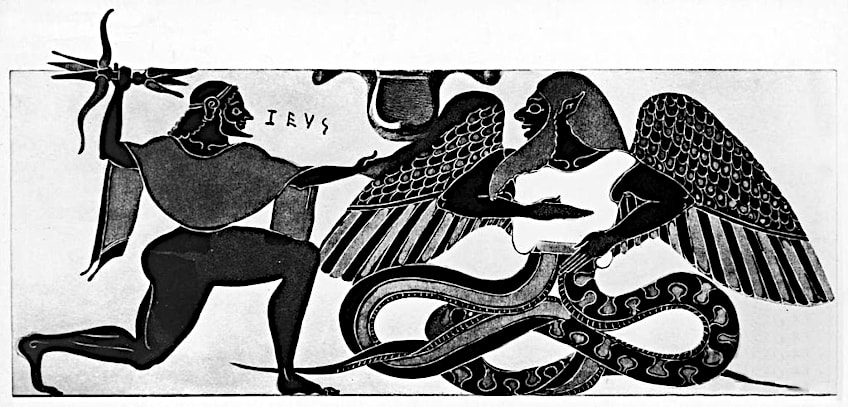 Drawing of the Battle between Zeus and Typhon (1811) copied from a Chalkidian hydria (c. 550-530 BCE); numérisation Google, Public domain, via Wikimedia Commons
Drawing of the Battle between Zeus and Typhon (1811) copied from a Chalkidian hydria (c. 550-530 BCE); numérisation Google, Public domain, via Wikimedia Commons
Zeus and Athena
Zeus wanted to end the cycle in which divine father is overthrown by one of his sons. So when Gaia and Uranus warned Zeus that his marriage to the Titaness Metis (wisdom) would result in a son capable of overthrowing him, Zeus did what Uranus had done to his children, and swallowed Metis. Soon afterwards, Zeus began to suffer from a debilitating headache. It was so severe that he ordered Hephaestus to split his head open with an axe, at which point a young woman sprang from Zeus’ head fully armed.
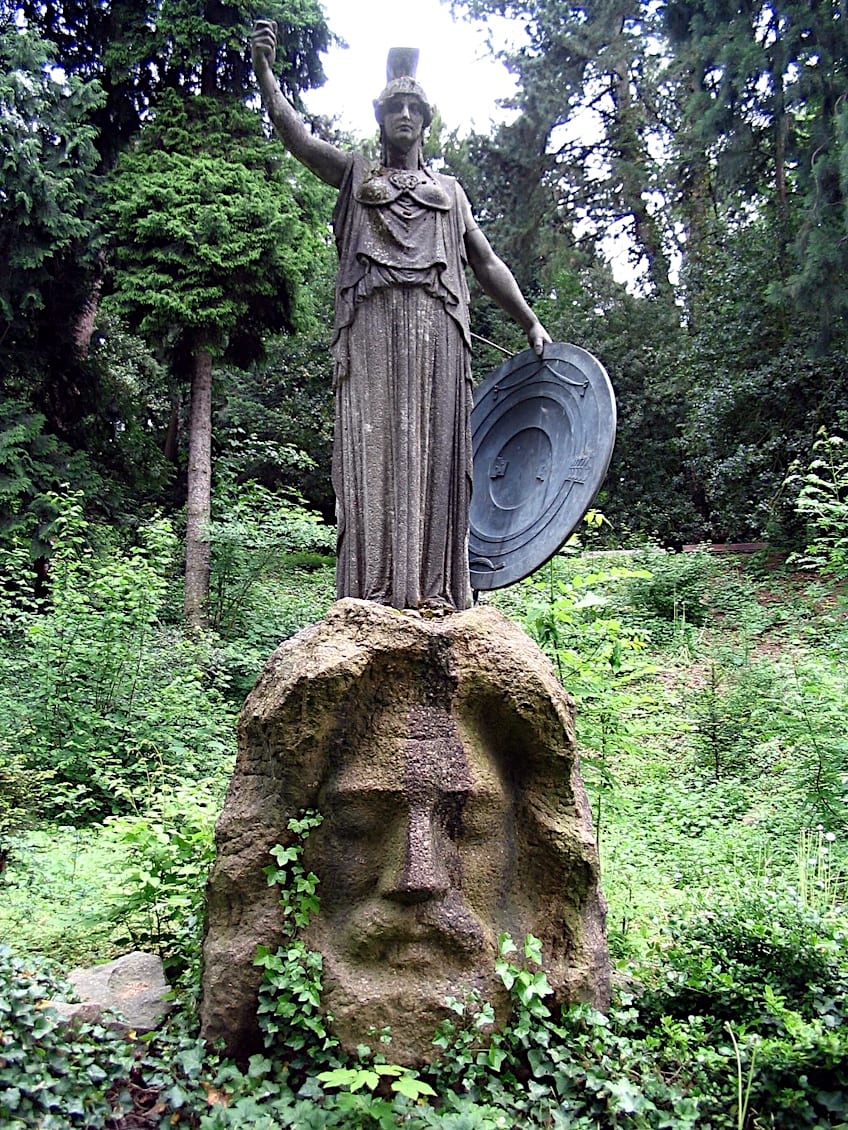 Athene statue and Zeus head at the Athene fountain at Karlshöhe in Stuttgart; Stefan Frerichs (Stefan) (SteFre at de.wikipedia), CC BY-SA 2.0 DE, via Wikimedia Commons
Athene statue and Zeus head at the Athene fountain at Karlshöhe in Stuttgart; Stefan Frerichs (Stefan) (SteFre at de.wikipedia), CC BY-SA 2.0 DE, via Wikimedia Commons
This daughter named Athena would become Zeus’ closest ally, assisting his sons and his favorite heroes in all their adventures. While Zeus expressed his deep distaste for his son Ares, the god of mindless and violent conflict, Athena as goddess of strategy was his firm favorite.
Because Zeus had been warned about the potential threat to his reign and took action, the Olympian order that he established put an end to the chaos of prior generations’ continuous divine regime changes.
The Legacy of Zeus
Zeus, the ruler of the gods, has left an indelible mark on modern society and media. His persona and stories have been transformed and recreated in a wide range of media, from literature to cinema and television, and he remains a famous figure in the popular imagination today. The persistent attraction to the concept of heavenly power and authority is one explanation for his continuing popularity. Zeus often appears as an all-powerful king capable of directing the elements and choosing the fates of both mankind and gods.
The depiction of Zeus as a deity of tremendous power and authority has influenced innumerable works of fiction, ranging from comic books to fantasy novels, in which protagonists with god-like abilities often appear as larger-than-life personalities.
A further explanation for his appeal is the story’s timeless themes. The tale of Zeus and his rise to prominence through his battles with the Titans and his father, as well as his countless love relationships and clashes with other deities, continues to captivate modern audiences.
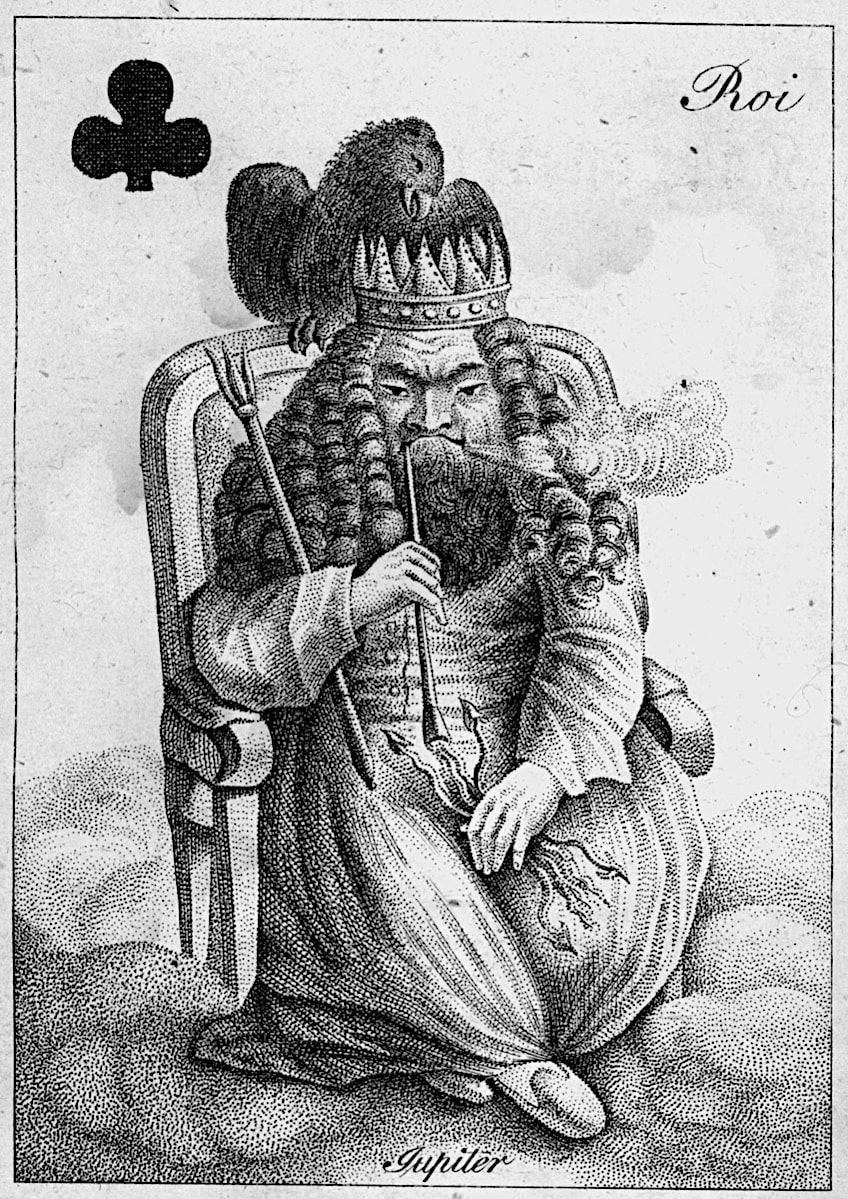 Zeus/Jupiter as the King of Clubs on a playing card published by G. Reinbeck, Tübingen, J. G. Cotta (1810); http://www.bassenge.com/, Public domain, via Wikimedia Commons
Zeus/Jupiter as the King of Clubs on a playing card published by G. Reinbeck, Tübingen, J. G. Cotta (1810); http://www.bassenge.com/, Public domain, via Wikimedia Commons
Themes of deceit, vengeance, and the pursuit of authority and dominance are still important today, and Zeus’ narrative gives a foundation for delving into these concepts. Furthermore, the enduring impact of Zeus and the other Olympians has had an enormous influence on literature, art, and philosophy throughout history. Classic standards of aesthetic perfection and proportion espoused in ancient Greece continue to affect creative traditions nowadays, and Greek philosophy has had a major influence on Western thought.
That completes our facts about Zeus, the king of the Olympians. Zeus followed in the footsteps of numerous father-like Indo-European gods of the time, strongly resembling a comparable, Proto-Indo-European divinity referred to as “Sky Father”. The early centuries of Zeus as King of the Gods were, essentially, a test run. On Olympus, life was not going well. He was dealing with the Titanomachy’s tumultuous aftermath, as well as an almost successful revolt at the hands of a few of his closest family members. Being the king of the gods is no easy feat, and Zeus had to take on many enemies due to his lofty position in the Greek pantheon. However, he proved to have all the necessary attributes and characteristics to hold onto the cosmic throne.
Frequently Asked Questions
What Were Zeus’ Symbols?
Zeus is seen in several artistic renderings with an oak crown or a wreath of oak leaves. As a storm deity, Zeus was naturally associated with lightning bolts. Bulls were a sign of authority, manhood, determination, and fertility throughout numerous ancient societies. In the Europa myth, Zeus was said to have transformed himself into a tame white bull in order to protect his new bride, Europa, from Hera’s jealous anger. Zeus’ favorite bird was the eagle. According to some legends, eagles would transport lightning bolts for the deity of the sky. Eagle figurines were frequently observed in Zeus’ temples.
Who Was Zeus’ Wife?
His wife was also his sister, and her name was Hera. Zeus was notoriously unfaithful to his wife in some of the most well-known Greek tales. He had a penchant for being immoral and pursued multiple mortal women – or any lady who wasn’t his wife. Hera, as a goddess, was known for being extremely vindictive. Even the gods dreaded her because she had an unrivaled capacity to maintain a grudge. Ironically, she is the goddess of marriage! Not even the gods’ lives are perfect.

I am deeply passionate about history and am constantly fascinated by the rich and complex stories of the past. As the editor-in-chief of learning-history.com, I have the opportunity to share this passion with a wide audience through the creation and distribution of engaging and informative content about historical events, persons, and cultures. Whether it’s through writing articles and blog posts or creating videos or podcasts, I strive to bring the past to life in a way that is both accurate and enjoyable. My expertise in history, combined with my strong writing and communication skills, allows me to effectively communicate complex historical concepts and make them accessible and interesting to a wide range of readers. I am truly grateful for the opportunity to share my love of history with others through my work on learning-history.com.

